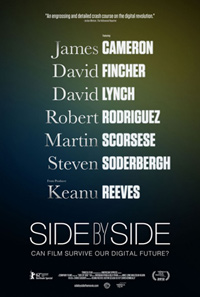Film vs. digital doc obscures message with overt Hollywood deference
 From the opening Oscar broadcast-style montage of iconic movie clips (apparently it is only Hollywood, and not international cinema, that was able to “inspire us, thrill us, and capture our imagination”), Chris Kenneally’s documentary Side by Side, which weighs the pros and cons of traditional photochemical filmmaking against fast-encroaching digital image capture and projection, indulges Hollywood pretense to the point that a potentially revealing snapshot of a great art form in transition becomes overwhelmed by industry self-congratulation. The movie is made by insiders, for insiders; it pretends to be addressed to the general populace (narrator Keanu Reeves “educates” the viewer, PSA-style, as to what the “job” of the cinematographer is) only as a ploy to indulge the big name participants’ ego-stroking fantasy that everyday American toilers could care a lick about their “workflow” problems.
From the opening Oscar broadcast-style montage of iconic movie clips (apparently it is only Hollywood, and not international cinema, that was able to “inspire us, thrill us, and capture our imagination”), Chris Kenneally’s documentary Side by Side, which weighs the pros and cons of traditional photochemical filmmaking against fast-encroaching digital image capture and projection, indulges Hollywood pretense to the point that a potentially revealing snapshot of a great art form in transition becomes overwhelmed by industry self-congratulation. The movie is made by insiders, for insiders; it pretends to be addressed to the general populace (narrator Keanu Reeves “educates” the viewer, PSA-style, as to what the “job” of the cinematographer is) only as a ploy to indulge the big name participants’ ego-stroking fantasy that everyday American toilers could care a lick about their “workflow” problems.
Interviewer/narrator Reeves is enthusiastic and seems genuinely curious about the issues at hand, which are elucidated, sometimes glibly, by a lengthy list of brand names— James Cameron, George Lucas, Martin Scorsese, Vittorio Storaro, and on and on. But no matter how well-meaning Keanu and Kenneally might be, it’s hard not to suspect that the real purpose behind the enterprise is the prominent promotion (complete with shiny, store-room lighting close-ups) given to the latest HD camera models from manufacturers like Arri, Sony, and RED.
The movie does explore one topic with universal implications, though without fully exploring its consequences: As cultural products — movies, music, everything — are increasingly being archived digitally in unstable, sure-to-expire hard drives, has a doomsday clock started ticking down to total cultural extinction?
Kenneally is careful not to present the film/digital divide as merely a generational conflict: Younger DPs like Reed Morano talk about their allegiance to 35MM, while no less than legendary genius Vilmos Zsigmond (‘McCabe and Mrs. Miller,’ ‘Obsession,’ ‘Close Encounters’) begrudgingly allows that if forced to, he might be able to achieve an image with a dynamic range comparable to film if he used the Arri Alexa. It’s pitiful, if not profane, that the most outspoken proponent of the aesthetic necessity of photochemical film should be the aesthetically handicapped Christopher Nolan, a director most conspicuous for his complete lack of cinematic instinct. Responsible for a series of monotone, dehumanized movies, his insistence on the inherent beauty of projected film seems plagiarized and phony.
For all the earnestness offered by masters like Dick Pope (“I am totally uninterested in 3D”), Michael Chapman (“Cinema was the church of the 20th century”), and Michael Ballhaus (the longtime collaborator of R.W. Fassbinder turned down post-production coloring sessions for the magisterial ‘Gangs of New York’ because “we shot it the way we wanted it the first time”), there is an equal amount of opportunism on display. For example, bland technician Steven Soderbergh smugly gloats that the digital technology he adamantly favors represents “a revolution that threatens the status quo”—he may see himself as a filmmaking Che, but nothing could be less revolutionary than his own soulless exercises in empty style. We are also subjected to Lena Dunham, the self-designated ambassador to baby boomers for the tribe of over-privileged twentysomethings (she speaks “baby boomer” as a second language), pontificating that going to the movies is no longer “going on.”
As far as the liberating democratization that digital technology is supposed to bring about (it’s now become a clichéd industry messiah fantasy that some “kid in a trailer in Ohio” will emerge with a camcorder to be “the next Orson Welles”), David Lynch offers the most grounded observation when he reminds us that, “everybody and his little brother has a piece of paper and a pencil. But how many great stories have been written?”
It’s a disturbing thought that all of our culture’s creative efforts will, in the not-so-distant all-digital future, be vulnerable to the threat of instantaneous extinction, a plight more precarious than that of a natural species on the endangered list. But the more crucial question is, who’s bothering to make anything worth keeping?


